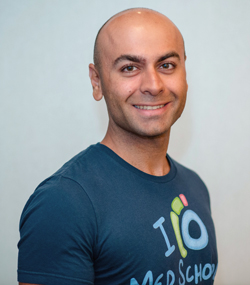2014 Winner
Osmosis
Making Medical Education Efficient and Engaging

Osmosis seeks to empower the world’s clinicians and caregivers with the best medical learning experience possible, making it easier to learn, gain, and update medical knowledge. Catalyst talked with cofounder Shiv Gaglani about his experience as an education entrepreneur and his advice for those aspiring to take a similar path.

Tell us about your enterprise.
Medical education is different than other forms of education because it’s vast, high stakes, and always changing. Osmosis views itself as the personal learning assistant to health professionals. We have a best-in-class video library of short engaging animated videos covering everything from atrial fibrillation to Zika virus. Anyone who wants to learn about health and medicine, whether it’s a parent, a practicing clinician, or nursing student, can use our video library. For countless students we help replace long, inefficient lectures with efficient, engaging, and enjoyable shorter videos. The former team from Khan Academy Health and Medicine works with us, and we have great teachers on staff.
How did you come to enter the EBPC?
My cofounder Ryan Haynes and I were anatomy learning partners at Johns Hopkins with a personal interest in making medical education more efficient. We set out to build a learning platform for ourselves and our classmates, solving our own pain point. Three months into it, we were receiving use requests from our classmates’ friends at schools like Tufts and Northwestern. We decided to dedicate our summer to building an education platform and then to take time off from med school to pursue it as a business.
We were selected for the DreamIt Health incubator in 2013 and moved to Philadelphia, which is an incredible city for education and healthcare. The incubator was a great experience. We went from having 200 users when we entered the program to 5,000 when we finished.
We applied to the Milken-Penn GSE Education Business Plan Competition in early 2014 because it’s the most prestigious of the education business competitions. It has great alumni and is overseen by the respected home institution of Penn GSE and Bobbi Kurshan, who is a very influential figure in education technology. We were thrilled to win the overall award and the American Public University System Award.
What role has the EBPC played in the Osmosis story?
The impact Milken-Penn had on our business was significant. It was our first education competition, and it was eye opening. The contacts we made were formative. The judges and other participants are super-impressive people and that gives you a strong network of people, strategically aligned, with what you are doing whether you win or lose. And, of course, the financial award made a huge impact on our company. As a startup, it gave us months of runway. The win also put us on the map. There were great articles about our win in Edsurge and Technical.ly Philly, and we received a lot of inbound interest from investors, even though we weren’t raising money. Our customers, both direct users and institutions, felt validated in choosing us when we were recognized by Penn GSE for our work.
What business results are you finding with Osmosis?
We have over I million subscribers on Youtube and about 500,000 registered overall users on our platform. Tens of thousands of those are paying customers — nursing, medical, physician assistant, pharmacy, and dentistry students, residents, trainees, and practicing clinicians in the US and abroad who are buying Osmosis subscriptions to get access to more content and more powerful features. End-user subscriptions are our number one revenue stream. We also have over 30 institutions that have purchased institutional subscriptions – schools like University of Michigan, University of Vermont, and international programs like Curtin University in Australia and Lund University in Sweden. And then we also have a mix of sponsorship and advertising revenue as well.
What is next for Osmosis?
We have an ambitious goal of having educated one billion people by 2025. That clearly isn’t all on the Osmosis platform. We have videos on Youtube. Our schizophrenia video, for example, has been seen over a million times. We are working towards our goal with translation efforts and by expanding distribution channels. Our estimate right now is that our content has been viewed by about 10 million people in aggregate. So we are one percent of the way there!
What advice would you give to aspiring education entrepreneurs?
Pay attention to the right metrics. Entrepreneurs often think the fundraise or the award is the validation and forget that the customer is the end goal. Are you making a difference? Are you improving their outcomes? Are you getting more customers because you have a high net promoter score? Never forget that the reason you exist is to solve the problems for the users. I talk to customers every day.
What advice would you give to aspiring education entrepreneurs?
Pay attention to the right metrics. Entrepreneurs often think the fundraise or the award is the validation and forget that the customer is the end goal. Are you making a difference? Are you improving their outcomes? Are you getting more customers because you have a high net promoter score? Never forget that the reason you exist is to solve the problems for the users. I talk to customers every day.
Also, don’t forget to enjoy the journey. It’s easy to get wrapped up in the next milestone. But I’ve found the highest satisfaction from working on Osmosis is really the day-to-day with our team. We have a strong company culture, and many coworkers have become close friends. Make sure the people you are with are people you want to be with daily, because you are in the trenches together.